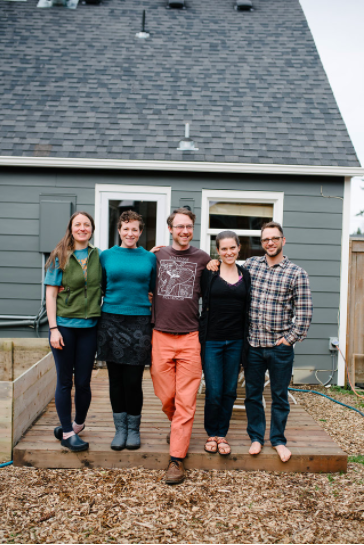Kristina of Kristina Lynn Photography snapped this pic of the Going Places crew earlier this spring. We're honing in on our community decision making process as we settle in.
This past weekend I had the opportunity to teach a Tiny House Community & Zoning Workshop through the Tiny House Collaborative. This workshop includes information about the different community models we're seeing and suggestions for how to create a tiny house community. Every time I teach the workshop I have the opportunity to reflect on Simply Home Community & Going Places, the two tiny cohousing communities I've lived in (and helped to create). So I thought I'd tell you a little about the community decision making process we're using at Going Places.
Here at Going Places we have been slowly crafting our Community Living Agreements together. When we kicked off the community in February, we hadn't refined our community decision making process so the first month or so it was sometimes tricky to figure out how to move forward on something. Figuring out a decision making process was one of the first decisions we made together as a community. What we landed on is a system that allows us to gauge interest really quickly by offering literal thumbs ups for proposals we're excited about.
Here's our Decision Making Philosophy & you'll find our Decision Making Process below:
Decision Making Philosophy
- We value inclusiveness and participation in decision-making and realize this requires willingness to compromise and honor individuality.
We recognize there’s a spectrum for decision-making between faster head-boss decisions and slower consensus-based decisions. We want to use consensus, but recognize that emergencies and some other types of decisions fall to the executive side of the spectrum (i.e. only impact 1-2 people).
We don’t need everyone for every decision, but especially at first, we want to air on the side of consensus. As we get to know each person's preferences and needs we’ll have more clarity about when we really need consensus.
Whenever something impacts the property in a long-term way property owners must be thumbs up.
Decision Making Process
Here’s our decision making process:
Someone makes a proposal, as clearly and concisely as possible via text message, or via the meeting agenda topics, and calls for a show of thumbs. If the proposal comes through text everyone should respond within 24 hours.
Thumbs up = let’s go for it and I’m excited enough to help
Thumbs sideways = I’m neutral, don’t care/mind either way
Thumbs down = I have questions or concerns that need to be addressed before I can support this proposal
The person who made the proposal checks in with anyone who was thumbs down to ensure that their questions and concerns are addressed.
If the concerns can be addressed and the person changes their vote to a thumbs up or neutral the proposal moves forward.
If the concerns cannot be addressed between the proposer and the person with questions or concerns, the topic comes to a community meeting for discussion, revision and/or approval.
The person who makes the proposal works to close the proposal. If there is someone who is thumbs down the proposer follows up with them to resolve it. Anyone who is thumbs down can offer a counterproposal.
If a proposal gets complicated (i.e. at least one of us can’t follow it on the text thread) we’ll bring it to a meeting.
So far we've found that this decision-making process gives us a balance between planning and spontaneity. It allows us to get buy-in for projects and ideas. There have been several proposals that were easier to resolve in person than on a text thread, but the texting option works well for little decisions (like "hey, are you okay with me planting the little triangular raised bed with tomato plants tomorrow?")
There are, of course, thousands of ways to set up community decision making. How does your community, organization, etc. do it?


